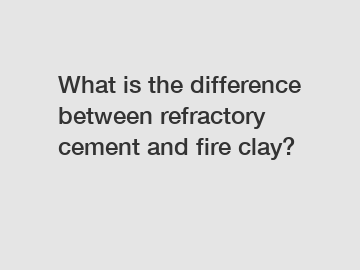What is the difference between refractory cement and fire clay?
What is the difference between refractory cement and fire clay?
Refractory cement and fire clay are both materials that are commonly used in high-temperature applications such as furnace linings, kilns, and fireplaces. While they serve similar purposes, there are distinct differences between refractory cement and fire clay in terms of their composition, properties, and applications.
Composition:

Refractory cement, also known as high temperature cement, is a specialty cement that is specifically formulated to withstand high temperatures. It is made by mixing a combination of raw materials such as alumina, silica, lime, and other additives. The precise blend of these components gives refractory cement its excellent resistance to extreme heat.
On the other hand, fire clay is a type of clay that is used in the making of heat-resistant mortar. It is composed primarily of alumina and silica, with lesser amounts of other minerals. Fire clay has a higher percentage of alumina compared to refractory cement, making it a more suitable choice for applications that experience moderate temperatures.
Properties:
Refractory cement exhibits exceptional strength and durability, even under high temperatures. It can withstand temperatures ranging from 2,500 to 3,000 degrees Fahrenheit (1,371 - 1,648 degrees Celsius), making it ideal for industrial applications that involve intense heat. Refractory cement also has low porosity, which improves its resistance to thermal shock.
Fire clay, although not as resistant to extreme temperatures as refractory cement, still performs well under moderate heat conditions. It can withstand temperatures up to 2,300 degrees Fahrenheit (1,260 degrees Celsius). Fire clay also has reasonable insulating properties, allowing it to retain heat for longer periods. However, compared to refractory cement, fire clay has higher porosity, which can result in decreased strength and increased vulnerability to thermal shock.
Applications:
Refractory cement finds extensive use in various industries that require materials capable of withstanding high temperatures. It is commonly used for lining furnaces, incinerators, kilns, and other thermal processes. Refractory cement is also utilized in the construction of fireplace surrounds, chimneys, and wood-burning stoves. Its high strength and resistance to extreme heat make it suitable for these demanding applications.
Fire clay, due to its lower temperature resistance and pore structure, is frequently used in applications where moderate heat is involved. It is commonly employed for constructing fireplaces, fire pits, and pizza ovens. Fire clay is also utilized in the creation of brick and mortar for residential and commercial projects that require heat-resistant materials. Its insulating properties and reasonable thermal resistance make it a popular choice for these applications.
Conclusion:
In conclusion, refractory cement and fire clay are both essential materials for applications that involve high temperatures. While refractory cement is prized for its exceptional strength and ability to withstand extreme heat, fire clay offers reasonable heat resistance and insulating properties. The choice between refractory cement and fire clay depends on the specific requirements of the project, including the temperature range and the level of thermal shock resistance needed.
For more information or assistance with choosing the right material for your high-temperature application, please feel free to contact us. Our knowledgeable team will be happy to help you make an informed decision.
If you want to learn more, please visit our website high alumina bricks, industrial furnaces refractory bricks, industrial furnaces refractory bricks.


